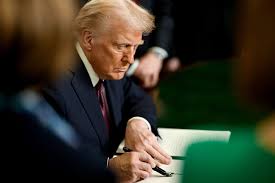U.S. President Donald Trump said on Friday he would impose hefty new tariffs of 25% on goods from Mexico and Canada and 10% on imports from China, and nothing could be done by the three countries to forestall them.
Trump did, however, reference a potential carve out for oil from Canada, saying that rate would be 10% versus the 25% planned for other goods from the United States’ northern neighbor. But he indicated wider tariffs on oil and natural gas would be coming in mid-February, remarks that sent oil prices higher.
Trump has been threatening the tariffs for weeks, saying they would be imposed on Feb. 1 and remain in place until the countries did more to stem the flow of both migrants and fentanyl over the U.S. border.
Speaking to reporters in the Oval Office as he was signing executive orders, Trump said he understood the duties could result in higher costs being passed on to consumers and acknowledged his actions may cause disruptions in the short term. Most economists estimate such sweeping import taxes, and the likely retaliation, would disrupt economic activity around the globe.
Asked if there was any opportunity at this stage for the three top U.S. trading partners to win a delay, Trump said: “No, no. Not right now, no.”
He brushed away the notion his threats for levies have been a bargaining tool. “No, it’s not … we have big (trade) deficits with, as you know, with all three of them.”
“It’s something we’re doing, and we’ll possibly very substantially increase it, or not, we’ll see how it is,” Trump said. “But it’s a lot of money coming to the United States.”
And more tariffs are on the way, the Republican president said, saying import taxes were being considered on European goods as well as on steel, aluminum and copper, and on drugs and semiconductors.
“We’re going to be putting tariffs on steel and aluminum, and ultimately copper. Copper will take a little longer,” he said.
Financial markets have been whipsawed by the rapid-fire but still not fully clear developments on Trump’s tariff plans, with currency trading showing particular volatility. The Canadian dollar and Mexican peso both weakened while Treasury bond yields rose, and stocks ended the day lower.
Still, he said he was not concerned about the reaction of financial markets to his plans to impose tariffs.
“The President will be implementing tomorrow 25% tariffs on Mexico, 25% tariffs on Canada, and a 10% tariff on China for the illegal fentanyl that they have sourced and allowed to distribute into our country, which has killed tens of millions of Americans,” White House spokesperson Karoline Leavitt told a press briefing.
Source: Reuters




